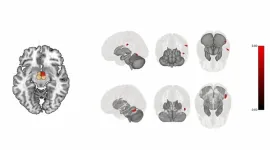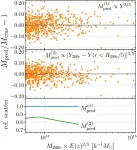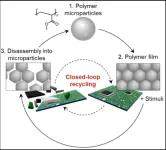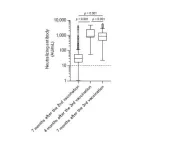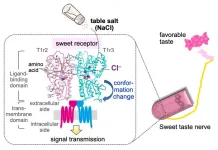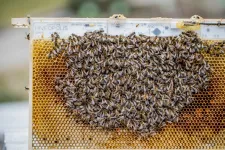(Press-News.org) Physical exercise practiced by patients submitted to bariatric surgery acts on brain regions involved in food intake, reducing hunger or accelerating satiety, for example. This was the result observed in a clinical trial conducted at Hospital das Clínicas (HC), the hospital complex run by the University of São Paulo’s Medical School (FM-USP) in Brazil. An article on the study, pointing to positive effects of exercise on obesity-related conditions in post-bariatric patients, is published in the International Journal of Obesity.
The study showed that an exercise training program starting three months after bariatric surgery produced functional alterations in brain networks associated with food intake and modified by obesity. The findings confirm the hypothesis that exercise and bariatric surgery act synergistically on the connectivity among brain regions associated with cognition, reward and emotional regulation, potentially moderating hunger and enhancing satiety.
According to the article, exercise increased the connectivity between the hypothalamus (the brain region that controls homeostasis, including regulation of appetite and energy expenditure) and the brain’s sensory areas. At the same time, it apparently decreased the link between the default mode network, which is more active during a resting state, and the salience network, the brain region involved in decision-making.
The researchers also found that exercise after bariatric surgery appeared to modulate the medial hypothalamic nucleus involved in appetite suppression and increased energy expenditure.
“The regulation of energy expenditure is governed by multiple internal and external signals. People with obesity display major dysregulation of brain regions associated with appetite and satiety. Our study showed that exercise by post-bariatric patients helped ‘normalize’ these complex networks so as to improve the central control of food intake. For example, some of these regions are activated and connect more intensely in people with obesity when they eat fatty or sugary food, increasing their desire to consume such food. We found that exercise counteracts this effect, at least in part,” Bruno Gualano, last author of the article, told Agência FAPESP. Gualano is a professor at FM-USP.
The study was supported by FAPESP via a research grant for the project “Effects of exercise training in patients undergoing bariatric surgery: a randomized clinical trial” and was part of the PhD research of Carlos Merege Filho, first author of the article, with a scholarship from FAPESP. The co-authors included Hamilton Roschel, Marco Aurélio Santo, Sônia Brucki, Claudia da Costa Leite, Maria Concepción García Otaduy and Mariana Nucci (all of whom are affiliated with HC-FM-USP); and John Kirwan of Pennington Biomedical Center (USA).
Considered one of the world’s main public health problems, obesity is a chronic disease characterized by excessive body fat accumulation and a major risk factor for cardiovascular and musculoskeletal disorders, as well as severe COVID-19. The parameter used for diagnosis in adults is body mass index (BMI), defined as weight in kilograms divided by height squared in meters. A BMI between 25 and 29.9 indicates overweight, while 30 or more signals obesity, according to the World Health Organization (WHO).
Brazil has one of the highest rates of overweight and obesity in the world. According to projections, almost 30% of the adult population will be obese in 2030. A billion people, or 17.5% of the world’s adult population, will be obese by then, according to the World Obesity Atlas 2022 published by the World Obesity Federation.
Importance
From the clinical standpoint, Gualano believes, the findings suggest that exercise should be considered an important complementary therapy to improve brain functions and enhance the known benefits of bariatric surgery, such as a reduction in cardiometabolic risk factors, as well as preservation of muscle mass and bone health.
He and his group have been conducting research in this field since 2018, as evidenced by other publications, one of which showed that exercise attenuated and reversed loss of muscle mass, improving muscle strength and function in post-bariatric patients. Genotypic and phenotypic analysis evidenced metabolic and structural remodeling of skeletal muscle.
In another study, exercise reduced risk factors for diseases associated with obesity, such as diabetes, high blood pressure and atherosclerosis (hardening of the arteries), by increasing sensitivity to insulin, combating inflammation and improving the health of blood vessels.
Methods
The randomized clinical trial reported in the International Journal of Obesity involved 30 women aged between 18 and 60 who had been submitted at HC-FM-USP’s bariatric surgery unit to a Roux-en-Y gastric bypass, which creates a small stomach pouch to restrict food intake and bypasses a large portion of the small intestine to limit calorie absorption. A majority of patients admitted to the unit are women.
Half the study sample were randomly assigned to a six-month exercise program of resistance and aerobic training three times a week, starting three months after the operation and supervised by a team of physical education professionals.
Clinical, laboratory and brain functional connectivity parameters were assessed at the start of the trial, as a baseline, and again three and nine months after the operation. Functional magnetic resonance imaging (fMRI) was used to detect connectivity between anatomically distinct brain areas organized as networks, and to analyze the combined effects of the surgical procedure and exercise training. Data collection began in June 2018 and ended in August 2021.
“The literature has already shown that post-bariatric patients have many brain alterations compatible with improved control of appetite, satiety and hunger in neural circuits that govern food intake. Our study found that exercise training bolstered this response,” Gualano said, noting the importance of lifestyle changes to maintain the benefits of weight loss for people with obesity.
Bariatric surgery can currently be performed on patients with a BMI of between 30 and 35 and type 2 diabetes that has not been controlled for more than two years, and patients with a BMI over 35 who have other diseases associated with overweight, such as high blood pressure, sleep apnea or hepatic steatosis (fatty liver disease). For people with comorbidities, the recommended BMI is over 40.
In the past five years, 311,850 bariatric surgeries have been performed in Brazil; 14.1% were paid for by the SUS (Sistema Único de Saúde), the national health service. The rest were covered by insurance policies or paid for privately, according to the Brazilian Bariatric and Metabolic Surgery Society (SBCBM).
“Regular exercise is known to induce several physiological adaptations that translate into health benefits. These benefits are reversed if the patient stops exercising regularly. Our study didn’t measure the duration of the brain changes induced by exercise, however. They’re highly likely to diminish and possibly even go into reverse as the amount and intensity of exercise decrease. It’s crucial to adopt a healthy lifestyle in order for the responses to bariatric surgery to be long-lasting,” Gualano said.
Next steps for the research group will include studying the effects in people with obesity of exercise and diet combined with other weight loss strategies, including new drugs such as peptide analogs or incretin mimetics, a class of medications commonly used to treat type 2 diabetes. Incretins are gut hormones that aid digestion and blood sugar control by signaling to the brain to stop eating after a meal.
In early January, the National Health Surveillance Agency (ANVISA) approved semaglutide as an anti-obesity drug for long-term weight management. The drug had previously been approved only for patients with type 2 diabetes. It is the first injectable anti-obesity medication available in Brazil and is supposed to be administered once a week. It is said to enhance satiety, modulate appetite and control blood sugar.
About São Paulo Research Foundation (FAPESP)
The São Paulo Research Foundation (FAPESP) is a public institution with the mission of supporting scientific research in all fields of knowledge by awarding scholarships, fellowships and grants to investigators linked with higher education and research institutions in the State of São Paulo, Brazil. FAPESP is aware that the very best research can only be done by working with the best researchers internationally. Therefore, it has established partnerships with funding agencies, higher education, private companies, and research organizations in other countries known for the quality of their research and has been encouraging scientists funded by its grants to further develop their international collaboration. You can learn more about FAPESP at www.fapesp.br/en and visit FAPESP news agency at www.agencia.fapesp.br/en to keep updated with the latest scientific breakthroughs FAPESP helps achieve through its many programs, awards and research centers. You may also subscribe to FAPESP news agency at http://agencia.fapesp.br/subscribe
END
Post-bariatric surgery exercise modulates brain regions associated with regulation of food intake
The findings suggest that exercise should be considered an important complementary therapy to improve brain functions and enhance the benefits of surgery, such as a reduction in cardiometabolic risk factors, preservation of muscle mass and bone health
2023-03-23
ELSE PRESS RELEASES FROM THIS DATE:
Closed loop for circular economy: new polymer recycling strategy ensures both high stability and complete recyclability
2023-03-23
The ever-increasing generation of plastic solid waste has resulted in global plastic pollution both on land and in the oceans. Projections show that plastic waste will double in the next 20 years, causing further environmental problems. Large amounts of plastic waste are, at present, incinerated or deposited in landfills. This not only degrades the environment but also depletes valuable resources.
In this light, recycling plastics such as polymers is a promising sustainable alternative for waste management. But this involves the breaking of chemical bonds between ...
Artificial intelligence discovers secret equation for ‘weighing’ galaxy clusters
2023-03-23
Astrophysicists at the Institute for Advanced Study, the Flatiron Institute and their colleagues have leveraged artificial intelligence to uncover a better way to estimate the mass of colossal clusters of galaxies. The AI discovered that by just adding a simple term to an existing equation, scientists can produce far better mass estimates than they previously had.
The improved estimates will enable scientists to calculate the fundamental properties of the universe more accurately, the astrophysicists reported March 17, 2023, in the Proceedings of the National Academy of ...
SARS-CoV-2 mRNA booster vaccinations increased and sustained the antibody responses
2023-03-23
Booster vaccinations against severe acute respiratory syndrome coronavirus 2 (SARS-CoV-2) are being promoted worldwide to counter the coronavirus disease 2019 (COVID-19) pandemic. Recent studies on the effectiveness of the third dose of the vaccine found improved efficacy against SARS-CoV-2 infection and a reduction in hospitalization. However, most studies on the effect of the third vaccination have been limited to a relatively short period of time after the third dose, and few longitudinal analyses of the effects of the third vaccination with an anti−SARS-CoV-2 vaccine have been reported.
Researchers from Tokyo Metropolitan Institute of Medical ...
How salt can taste sweet: the myriad mechanisms of taste perception
2023-03-23
Humans perceive five basic taste sensations: sweet, umami, bitter, salty, and sour. Specific foods trigger taste recognition of these sensations through the activation of different receptors in our taste buds. In the case for table salt, the concentration is also an important factor in determining taste. For instance, the preferable concentration of table salt is 100 mM, at which humans perceive a salty taste. However, higher concentrations of salt, over 500 mM, may be perceived as bitter and/or sour, while very low concentrations, below 10 mM, are perceived as sweet by humans. Scientific ...
mNGS outperforms microbiological tests to diagnose bloodstream infections – BGI Insight
2023-03-23
The research published in the Journal of Infection investigated the use of metagenomic next-generation sequencing (mNGS) in diagnosing bloodstream infections (BSIs) for immunocompromised hematology patients. Hematology patients are highly susceptible to BSIs, which can have severe consequences such as septic shock, multiple-organ failure, disseminated intravascular coagulation, and even death. An accurate and quick microbiological diagnosis of BSI is therefore essential for the control of the infection.
In the study, conducted ...
Beyond ‘good vs. bad’ – A new, more comprehensive approach to evaluate carbohydrate quality and improve health equity
2023-03-23
March 23, 2023 – Despite the broad diversity of the U.S. population, dietary recommendations often overlook the positive contributions of cultural foods to build healthy dietary patterns. This is especially true when it comes to carbohydrate food guidance, where prevailing approaches have historically focused on only three components— carbohydrates, sugar, and dietary fiber—ignoring other important nutrient and cultural considerations. However, a new paper published in Nutrients highlights a more holistic approach, called the Carbohydrate Food Quality ...
Robotic system offers hidden window into collective bee behavior
2023-03-23
Honeybees are famously finicky when it comes to being studied. Research instruments and conditions and even unfamiliar smells can disrupt a colony’s behavior. Now, a joint research team from the Mobile Robotic Systems Group in EPFL’s School of Engineering and School of Computer and Communication Sciences and the Hiveopolis project at Austria’s University of Graz have developed a robotic system that can be unobtrusively built into the frame of a standard honeybee hive.
Composed of an array of thermal sensors and actuators, the system measures and modulates honeybee behavior through ...
Octapharma USA grant supports PANS/PANDAS education event at NHIA Conference March 27 in Washington, D.C.
2023-03-23
PARAMUS, N.J. (March 23, 2023) – Octapharma USA has provided a grant for an educational program on pediatric acute-onset neuropsychiatric syndrome (PANS) and PANDAS, a subset of PANS associated with strep, to be held during the National Home Infusion Association (NHIA) Annual Conference scheduled for March 25 – 27 in Washington, D.C.
Octapharma is enrolling more patients and sites for its phase 3 multicenter superiority study comparing the effectiveness of panzyga® (immune globulin intravenous, human - ifas) 10% liquid preparation versus placebo ...
Scientists warn of rise in potentially fatal bacterial infection due to global warming
2023-03-23
Continued warming of the climate would see a rise in the number and spread of potentially fatal infections caused by bacteria found along parts of the coast of the United States.
Vibrio vulnificus bacteria grow in warm shallow coastal waters and can infect a cut or insect bite during contact with seawater. A new study led by the UK’s University of East Anglia (UEA) shows that the number of V. vulnificus infections along the East Coast of the US, a global hotspot for such infections, has gone ...
UTSA researchers exploit vulnerabilities of smart device microphones and voice assistants
2023-03-23
(SAN ANTONIO) MARCH 23, 2023 - Guenevere Chen, an associate professor in the UTSA Department of Electrical and Computer Engineering, recently published a paper on USENIX Security 2023 that demonstrates a novel inaudible voice trojan attack to exploit vulnerabilities of smart device microphones and voice assistants — like Siri, Google Assistant, Alexa or Amazon’s Echo and Microsoft Cortana — and provide defense mechanisms for users.
The researchers developed Near-Ultrasound Inaudible Trojan, or NUIT (French for “nighttime”) to study how hackers exploit speakers and ...
LAST 30 PRESS RELEASES:
Making lighter work of calculating fluid and heat flow
Normalizing blood sugar can halve heart attack risk
Lowering blood sugar cuts heart attack risk in people with prediabetes
Study links genetic variants to risk of blinding eye disease in premature infants
Non-opioid ‘pain sponge’ therapy halts cartilage degeneration and relieves chronic pain
AI can pick up cultural values by mimicking how kids learn
China’s ecological redlines offer fast track to 30 x 30 global conservation goal
Invisible indoor threats: emerging household contaminants and their growing risks to human health
Adding antibody treatment to chemo boosts outcomes for children with rare cancer
Germline pathogenic variants among women without a history of breast cancer
Tanning beds triple melanoma risk, potentially causing broad DNA damage
Unique bond identified as key to viral infection speed
Indoor tanning makes youthful skin much older on a genetic level
Mouse model sheds new light on the causes and potential solutions to human GI problems linked to muscular dystrophy
The Journal of Nuclear Medicine ahead-of-print tip sheet: December 12, 2025
Smarter tools for peering into the microscopic world
Applications open for funding to conduct research in the Kinsey Institute archives
Global measure underestimates the severity of food insecurity
Child survivors of critical illness are missing out on timely follow up care
Risk-based vs annual breast cancer screening / the WISDOM randomized clinical trial
University of Toronto launches Electric Vehicle Innovation Ontario to accelerate advanced EV technologies and build Canada’s innovation advantage
Early relapse predicts poor outcomes in aggressive blood cancer
American College of Lifestyle Medicine applauds two CMS models aligned with lifestyle medicine practice and reimbursement
Clinical trial finds cannabis use not a barrier to quitting nicotine vaping
Supplemental nutrition assistance program policies and food insecurity
Switching immune cells to “night mode” could limit damage after a heart attack, study suggests
URI-based Global RIghts Project report spotlights continued troubling trends in worldwide inhumane treatment
Neutrophils are less aggressive at night, explaining why nighttime heart attacks cause less damage than daytime events
Menopausal hormone therapy may not pose breast cancer risk for women with BRCA mutations
Mobile health tool may improve quality of life for adolescent and young adult breast cancer survivors
[Press-News.org] Post-bariatric surgery exercise modulates brain regions associated with regulation of food intakeThe findings suggest that exercise should be considered an important complementary therapy to improve brain functions and enhance the benefits of surgery, such as a reduction in cardiometabolic risk factors, preservation of muscle mass and bone health
